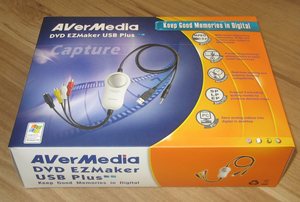The AverMedia DVD EZMaker USB Plus is a very useful device to capture video straight from your video tapes. I recently purchased one for $49.95 at Fry’s so that I could capture my videos on my computer.
I have found this video capture device very useful. One of the best things about the AverMedia DVD EZMaker USB Plus video capture device is that it attaches to a computer externally. There’s no need to crack the case on the computer, or struggle with installing an internal video card. Also, this video capture device can be easily removed and attached to another computer. Just plug the USB into a port, and place the jack in the line in on the back of your computer. The other end attaches to your VCR or video camera. I use an extension cable so that I don’t have to move my VCR.
Two pieces of software come with the AverMedia DVD EZMaker USB Plus; CyberLink PowerDirector 4.0 and CyberLink PowerProducer 3.0. CyberLink PowerDirector is a a video editor, and CyberLink PowerProducer is just an overblown DVD and CD burning program. I already have an adequate CD and DVD burning program on my computer, so I had no interest in PowerProducer.
I have used both of these pieces of software, and I find that CyberLink PowerDirector 4.0 is the one I need to use most often. With PowerDirector you can capture video and audio and save them in wide range of formats. MPEG 1 and MPEG 2 formats are available, as well as AVI format. This program can produce DVD quality video and audio from cassette tapes. I was producing videos to stream on the web, so I didn’t quite need all the features of this program. However, it did seem like PowerDirector was able to produce very high quality DVDs. However if you needed to alter the format or reduce the size, there was an option to “produce” the piece to Windows Media Video format. There are a large variety of different options in the program to reduce the size of the file as much as possible, without losing too much of the quality.
I got the best quality video by using an intermediate SVCD format, which captures video for Video CD rather than DVD. I then “Produced” the files to WMV in order to reduce their size. I imported these files into Windows Movie Maker, since I was more familiar with this program than with PowerDirector’s editor.
There is an edit feature in PowerDirector which allows you to edit videos much like in Windows Movie Maker. The editor has several different tracks: Video, Effect, PiP, Title, Voice and Music.
Just as an experiment, I tried using PowerDirector to re-make another video I’d created in Windows Movie Maker. The video track was easy enough to edit, but I found that the effects supplied with the PowerDirector CD were rather sparse. I needed a black and white effect, which PowerDirector didn’t have. I had to register and download additional templates and effects in order to even consider using the effects I was after.
The black and white effect I needed installed easily after I downloaded the pack. I inserted it into the effects field and it worked perfectly, although the methodology was a little different than in Windows Movie Maker. Creating titles in PowerDirector was different, too. I had to place a “color board” down in the movie, then place titles over that. The titles screen allowed me to select a font and place those titles either over the color of my choice, or over my video. Unlike Windows Movie Maker, Power Director allowed me to select the positioning of the titles. There was even a grid so that I could properly align the title on the page. However, there weren’t as many title effects in PowerDirector as in Windows Movie Maker. So my favorite title effect, fade in and fade out, wasn’t available.
The titles were a little more difficult to create than in Windows Movie Maker. I had to re-select my font and justification for each title I made. Then once a title was saved, I couldn’t edit it as in Windows Movie Maker. Instead, I had to delete the title and recreate it from scratch, which of course meant reselecting my font and justification all over again.
I had created my music files for this piece as Windows Media Audio in Windows Movie Maker, and PowerDirector imported them easily. However, several features of Windows Movie Maker were missing here as well. For example, when working in the PowerDirector Time Line, I unable to find the zoom feature which I regularly used in Windows Movie Maker, which permitted me to scrutinize the music and video timeline more closely. Also, in Windows Movie Maker, there was a visual bar to indicate the audio level. This bar was absent in PowerDirector, making me have to guess where I needed to trim my audio clip. Also, in Windows Movie Maker, there was an option to increase the volume of the audio track, which PowerDirector did not have. PowerDirector had the option to mute a track, including the video tracks, but I didn’t need that feature for this video.
The resultant video file was about 8 MB, and was about the same quality as what I’d produced with Windows Movie Maker. The titles, however, were a little blurry in comparison to what Windows Movie Maker creates. The program didn’t really have any major features which Windows Movie Maker didn’t have, and was missing several important features of Windows Movie Maker. It was also more difficult to use.
Another annoying thing about PowerDirector and PowerProducer is that both programs make promises about “magic” features which come with them. However, when you attempt to use these “magic” features, such as a “magic music generator,” the program tries to get you to upgrade to the Pro version.
Also, when I visited the CyberLink website, I discovered that this software was a little outdated. Version 6 is now the current version, and is available for a free trial. Perhaps the Pro version of CyberLink PowerDirector is good software, but I never got a chance to try its features. I think it’s pretty obnoxious for a software producer to force a customer to buy software before they’ve had a chance to try it out.
I edited a couple of other videos in PowerDirector after this. Both were music videos. I found that Cyberlink PowerDirector had several annoying defaults, including the tendency to edit my audio track when I edited my video track. This caused my music video to lose its sync. Also, clips tended to automatically jump back to their beginning when I clicked on them, rather than remaining where I wanted them to be within the track.
Overall, I found that there were few things in Cyberlink PowerDirector which were not available in Windows Movie Maker. There were several visual effects, most of which I had no use for. However, the “Color Replacer” effect was useful when I needed to do color correction on some video which had come out looking a little pinkish in the background.
I wouldn’t put my money down on CyberLink’s software products, but since they came free with my video capture device, I’ll take advantage of them. Overall, I find this video capture device very useful due to portability. It would have cost me at least $50 more to replace my video card, which I would not have been able to easily use on another computer. Of course, there are certain things it can’t do, such as capture video directly from the computer memory. I recommend this product if you need to easily attach and detach a VCR or video camera to and from multiple computers, or if you’re just looking to keep your video production costs down.



